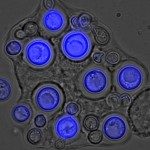Link to Pubmed [PMID] – 19778296
Clin. Microbiol. Infect. 2010 Jul;16(7):863-9
In routine laboratory practice, the determination of MICs of antifungals for yeasts often relies on the Etest, because of a good correlation with reference methods. However, this correlation was established through predesigned studies, rather than prospective testing. The surveillance programme of fungaemia (YEASTS programme), implemented since 2003, facilitated our comparison of the Etest and the EUCAST results, obtained on a routine basis in nine different hospitals and in a reference laboratory, respectively. The analysis included 690 isolates recovered from blood culture (362 Candida albicans, 113 Candida glabrata, 69 Candida parapsilosis, 55 Candida tropicalis, 31 Cryptococcus neoformans, and 60 other yeast species) that were tested for their susceptibility to amphotericin B (n = 655), fluconazole (n = 669), itraconazole (n = 198), voriconazole (n = 588), flucytosine (n = 314), and caspofungin (n = 244). Agreement between the Etest and EUCAST datasets was calculated and categorized on the basis of previously published breakpoints. The level of agreement at ±2 dilutions was 75% for amphotericin B and 90% for flucytosine; for the azoles, it ranged from 71% for itraconazole to 87% for voriconazole. No significant difference was observed among the yeast species, except for Cryptococcus neoformans and flucytosine, with an agreement <40%. Categorical agreement ranged from 60% for itraconazole to 90% for flucytosine. Major and very major discrepancies occurred in <12% and 6%, respectively. The Etest, even when performed on a routine basis, shows a ≥71% agreement with the EUCAST reference method.

